 |
|||||||||||||||||||||||||||||||||||||||||||
|
False
colour reveals Saturn's symmetrical banding in this Hubble Space Telescope
view.
|
|||||||||||||||||||||||||||||||||||||||||||
| THE ATMOSPHERE OF SATURN | |||||||||||||||||||||||||||||||||||||||||||
| A gas giant, Saturn has no solid surface and the markings on its surface vary over time. From a distance Saturn is a yellowish brown globe with some faint bands running across it. A closer look reveals a series of well defined latitudinal stripes. They are less pronounced and less cloudy looking than Jupiter's and less turbulent at their margins. Banding is symmetrical between the two hemispheres, those in the south having about the same width and colouration as their counterparts in the north. | |||||||||||||||||||||||||||||||||||||||||||
| Rotation | |||||||||||||||||||||||||||||||||||||||||||
| Like Jupiter the planet's rotation is divided into two systems, System I and System II. Equatorial System I takes 10 hours and 15 minutes to rotate. System II, the higher latitudes, lag behind taking 10 hours and 38 minutes to rotate. Some features of Saturn's surface move about the planet longitudinally, independent of the main rotation systems. | |||||||||||||||||||||||||||||||||||||||||||
| Belts and zones | |||||||||||||||||||||||||||||||||||||||||||
| The zone system used to describe Jupiter's coloured bands is also used to describe Saturn's. There are usually fewer visible zones on Saturn though. The North North Temperate Zone (NNTZ), (SSTZ), North North Temperate Belt (NNTB), and SSTB are not normally easy to distinguish. | |||||||||||||||||||||||||||||||||||||||||||
|
|||||||||||||||||||||||||||||||||||||||||||
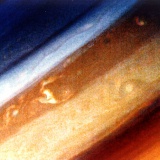 False colour reveals the banded nature of Saturn's atmosphere. |
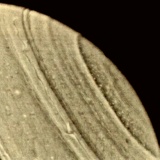 Saturn's polar regions tend to have narrower belts and zones. |
||||||||||||||||||||||||||||||||||||||||||
| Seasons | |||||||||||||||||||||||||||||||||||||||||||
| Saturn's axis of rotation is inclined so its aspect relative to the Sun varies as it orbits. It might therefore be reasonable to expect that there are seasonal variations in Saturn's surface temperature, just as the tilt of the Earth produces our seasons. The temperature gradient, or difference between maximum and minimum temperature, is just 5oC, so temperature differences are not as important in determining weather patterns as they are on Earth. Saturn is far from the Sun (1427 million kilometres) and receives far less energy than the inner planets. The rapid rotation of the planet and the fast moving winds also help to distribute heat efficiently. | |||||||||||||||||||||||||||||||||||||||||||
| The main component of Saturn's atmosphere is hydrogen. Because hydrogen makes up 97% of the total, the helium to hydrogen ratio is very small. The amounts present in the Sun are 71% hydrogen and 28% helium. The helium abundances of other gas giants are also far greater. Jupiter has about 24% and Uranus 15%, much closer to the solar composition. | |||||||||||||||||||||||||||||||||||||||||||
 Atmospheric composition. |
 Atmospheric composition. |
||||||||||||||||||||||||||||||||||||||||||
| The relative lack of helium in Saturn's atmosphere is ascribed to a process called "raining-out". After the formation of Saturn, conditions existed in which it was not possible for helium to intermix with hydrogen at certain depths. The two in their liquid state were immiscible and droplets of helium moved towards the interior of the planet. | |||||||||||||||||||||||||||||||||||||||||||
| Other important constituents of Saturn's atmosphere include methane (CH4) and ammonia (NH3). Spectroscopy (analysis of light) indicates the presence of less abundant molecules including carbon monoxide (CO) and phosphine (PH3) and rarer molecules like germane (GeH4. Methane is broken down by ultraviolet light and other hydrocarbons are produced in photo-chemical reactions taking place in the stratosphere. Such products include: acetylene (C2H2), ethane (C2H6), propane (C3H8) , and methylacetylene (H3C-CCH). There are probably various other complex molecules beneath the lower cloud decks but we cannot detect them. | |||||||||||||||||||||||||||||||||||||||||||
| Moving vertically through Saturn's atmosphere there are three main cloud layers. The uppermost bright-looking clouds are composed mainly of ammonia crystals, and like Jupiter's uppermost clouds are comparable to Earth's high altitude water ice cirrus clouds. On Saturn they occur at about 100 kilometres below the 0.1 atm (atmosphere) pressure level, where the temperature is about 150 K (-123oC). | |||||||||||||||||||||||||||||||||||||||||||
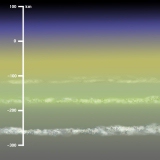 The structure of Saturn's atmosphere. |
|||||||||||||||||||||||||||||||||||||||||||
| With depth, the temperature rises as it does on the other gas-giants owing to increasing pressure and gases trapping shortwave radiation from the Sun. This layer is equivalent to the Earth's troposphere where convection takes place. At the base of the ammonia clouds occurs a hydrogen dominated layer, but as the pressure rises to about 4 atm and the temperature 200 K (-73oC) , ammonium hydrosulfide (NH4SH) crystals form. Impurities in the chemical composition, including phosphor compounds, are thought to be responsible for the brown colouration of the middle cloud deck. | |||||||||||||||||||||||||||||||||||||||||||
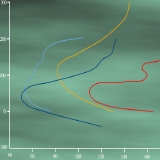 Temperature profile through Saturn's atmosphere. |
|||||||||||||||||||||||||||||||||||||||||||
| Still deeper within the atmosphere, the lower cloud deck is encountered. At 11 atm and about 0oC, 150 kilometres below the base of the upper cloud deck there are clouds of water ice crystals and ammonia droplets. | |||||||||||||||||||||||||||||||||||||||||||
| Moving below the lower visible clouds of the troposphere, pressure and temperature increase and gaseous hydrogen begins to grade into a liquid form. | |||||||||||||||||||||||||||||||||||||||||||
| Circulation | |||||||||||||||||||||||||||||||||||||||||||
| Weather, as we know it, is driven from above by solar heating. The weather observed Saturn and Jupiter is driven by internal heating and a rapid rate of rotation. | |||||||||||||||||||||||||||||||||||||||||||
| Windspeeds on the gas giants are determined by timing the movement of markings and clouds in the upper atmosphere. Winds on Saturn are quite unusual in that although they vary in intensity with latitude, they nearly all move in a prograde direction - that is, in the same direction as which the planet rotates. On the other gas giants, there are zones which move retrograde, opposite to the rotation of the planet. The fastest winds are recorded in the equatorial region (20oN to 20o S), where windspeeds reach 1800 kilometres per hour. Saturn's windspeeds are in places more than double that of its larger rival Jupiter. | |||||||||||||||||||||||||||||||||||||||||||
| At latitudes 45o and 65o, 540 kilometres per hour winds are detected. There are regions in the mid-latitudes though, where there appears to be no movement relative to the rotation of the planet. | |||||||||||||||||||||||||||||||||||||||||||
| One explanation of how such a symmetry occurs between the bands of the north and the southern hemisphere is that enclosing the metallic core of Saturn are zones which move as if a series of concentric cylinders are embedded in the planet. These cylinders have a nested configuration and are free to rotate independently of one another. Each cylinder moving about a central axis of rotation would have a symmetrical north/south cross-section. The different speeds at which they move gives rise to the different windspeeds on the surface. | |||||||||||||||||||||||||||||||||||||||||||
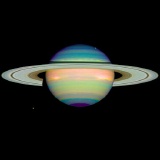 False colour reveals Saturn's symmetrical banding in this Hubble Space Telescope view. |
|||||||||||||||||||||||||||||||||||||||||||
| Features in the atmosphere of Saturn are generally confined to their latitudinal band, and in short periods move only longitudinally. The bands or, jets as they are sometimes known, are long-lived features and have been observed consistently for many years. | |||||||||||||||||||||||||||||||||||||||||||
| A very different band feature is observed in the Northern Temperate Zone at a latitude of 46oN. It is a thin dark ribbon-like line which encircles the planet. The wavelength of its peaks and troughs is roughly 5000 kilometres. Within the troughs to the north are storms which rotate in an anticlockwise direction. In the troughs to the south there are storms which rotate in the opposite direction. | |||||||||||||||||||||||||||||||||||||||||||
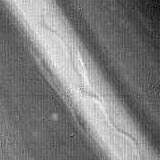 The thin dark ribbon is a wave that encircles Saturn. |
|||||||||||||||||||||||||||||||||||||||||||
| Evidence of convection is seen in the form of light-coloured wispy markings, which move within a westerly jet at about 39oN.The clouds have a chaotic appearance which resembles a droplet of ink or dye dispersing in still water, rather than a swiftly circulating plume erupting into a moving current. They occur only in the dark North Tropical Zone and are very short lived. The formation of convection clouds such as these is thought to involve a number of factors including changing conditions in the lower water ice cloud deck and internal heating. | |||||||||||||||||||||||||||||||||||||||||||
| Spots | |||||||||||||||||||||||||||||||||||||||||||
| There are other mobile, dynamic and sometimes very temporary features. There are spots, eddies, flows and regions of turbulence. These are more subdued and paler than those seen on Jupiter. They are also smaller and less dynamic than those on Jupiter. Spots are not particularly easy to see from Earth, but large scale disturbances do take place from time to time. Late 1990, a large white spot erupted in the equatorial zone. It spread out like the disturbances on Jupiter forming a band which after a time faded away. Spots on the surface, cyclonic features, or storms have rotation periods of their own and appear to move about independently of the cloud belts. | |||||||||||||||||||||||||||||||||||||||||||
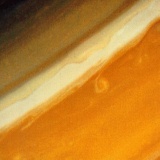 A short-lived storm shaped like the number 6, in Saturn's northern hemisphere. |
|||||||||||||||||||||||||||||||||||||||||||
| The main southern hemisphere spot is a large red oval spot known as Anne's Spot, located in the South Temperate Zone (55oS). Anne's Spot measures 5000 kilometres across its long axis and 3000 kilometres across its short axis. It was not known until the Voyager encounter when it was located and its easterly movement at about 100 kilometres per hour observed. It moves independently of the latitudinal band it lies within - the STZ which moves about 70 kilometres per hour in a westerly direction. There are no very detailed pictures of the structure unfortunately, because Voyager was unable to image the southern hemisphere at a very high resolution. | |||||||||||||||||||||||||||||||||||||||||||
 The large red oval is the 5000 kilometre diameter Anne's Spot. |
|||||||||||||||||||||||||||||||||||||||||||
| The red colour is ascribed to a phosphor compound (PH3)called phosphine which is concentrated in the deeper atmosphere. Phosphine is colourless but when it reaches the surface it is broken apart by ultraviolet light, producing red phosphor. | |||||||||||||||||||||||||||||||||||||||||||
| Saturn's spots probably form in the same way as those on Jupiter and Neptune. They may start as bumps or unstable regions deep within the atmosphere which develop into a plume. The plume streams up to the surface, spinning as it rises, forming a new storm system. In the northern hemisphere there are various different coloured spots. There is also one called the "UV Spot" which shows up only in UV light. Some of the spots occur at the boundaries of zones which have different wind speeds. Several brown spots are of considerable size, for example Brown Spot I at 42oN,measures 5,000 x 3,300 kilometres. Saturn's largest spot ,a red oval-shaped feature, is located at 72o, it is 10,000 kilometres x 6000 kilometres and nicknamed "Big Bertha". | |||||||||||||||||||||||||||||||||||||||||||
 Large brown anticyclone spots can be found in Saturn's northern hemisphere. |
|||||||||||||||||||||||||||||||||||||||||||
| Successive Voyager images show white spots evolving in the same band fairly close to one another which eventually interact. Moving together, White Spots I and II, did not merge immediately but rotated about the other. With time their margins begun to coalesce and some of their circulation pattern became shared. | |||||||||||||||||||||||||||||||||||||||||||
| It has taken some time to gain such an awareness of the complex and dynamic nature of Saturn's atmosphere. This is because of the lack of contrasting colours, as in Jupiter's atmosphere, which serve to highlight complex weather patterns. Cooler temperatures and lower atmospheric pressure mean that clouds form at levels where differences between them are not very conspicuous. A greater relative proportion of atmospheric haze also reduces the contrast between the layers and limits the amount of detail which can be seen. Despite this, the complexity, diversity, and dynamism of Saturnian weather is indeed a match for Jupiter's. | |||||||||||||||||||||||||||||||||||||||||||
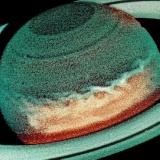 The dynamic nature of Saturn's hemisphere is evident in this false colour view from the Hubble Space Telescope. |
 Hubble Space Telescope image of a bright storm the size of the Earth. |
||||||||||||||||||||||||||||||||||||||||||
|
|
|||||||||||||||||||||||||||||||||||||||||||